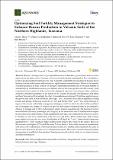Optimizing Soil Fertility Management Strategies to Enhance Banana Production in Volcanic Soils of the Northern Highlands, Tanzania

View/
Date
2020-02-18Author
Meya, Akida
Ndakidemi, Patrick
Mtei, Kelvin
Swennen, Rony
Merckx, Roel
Metadata
Show full item recordAbstract
Banana is an important crop in high altitude areas of Tanzania, grown widely both as a food
staple and as the main source of income. However, its production is constrained by low soil fertility, a
result of gradual nutrient mining by the crop. Currently, soil fertility management in banana-based
farming systems in the country relies mainly on applications of animal manure. However, the amount
of manure produced in most farms is not enough to replenish soil fertility due to the small number of
animals kept by smallholder resource-poor farmers who are the major producers in the country. Field
experiments were conducted at three sites with varying soil types and contrasting weather conditions
along the altitudinal gradients on the slopes of the volcanic mountains of Kilimanjaro and Meru,
northern Tanzania to (1) investigate the effect of mineral nitrogen (mineral N) fertilizer applications on
the growth and yield of Mchare banana (Musa spp., AA, a traditional East African highland cooking
banana sub-group), at the four levels of 0, 77, 153, and 230 kg N ha−1 year−1 as a starter strategy to
improve the current soil fertility management strategies, and (2) evaluate the effect of the combined
use of inorganic and organic N sources on growth and banana fruit production as an alternative
strategy to manage soil fertility and minimize animal manure requirements. The treatment factors
were trial sites (Tarakea, Lyamungo, and Tengeru) as the main factor and N fertilization strategies
(as urea alone, sole cattle manure, and in combination with urea, sole common bean (Phaseolus vulgaris
L.) haulms as well as in combination with urea) as a sub factor. Bean haulms and cattle manure
were applied each year for two years. Fertilization at 153 kg N ha−1 year−1 derived solely from urea
significantly (p < 0.001) resulted in high yield increment of up to 42% relative to the control. However,
the increase was highest (52%) with the same N dose derived from cattle manure in combination
with urea at 50% substitution. Sole bean haulms resulted in a smaller yield increment, the same as
the lowest N dose from the sole urea fertilization treatment. The study concludes that soil fertility
management in smallholder banana-based farming systems should not solely rely on animal manure
and mineral fertilizers.
